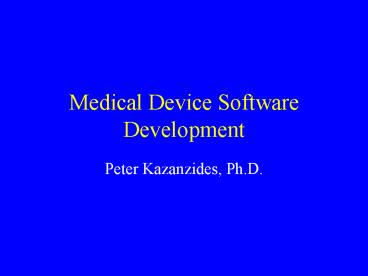Medical Device Software Development - PowerPoint PPT Presentation
1 / 27
Title:
Medical Device Software Development
Description:
ISO 9002: Manufacturing Only. ISO 9003: Inspection and Testing Only ... Quality System component that applies to product design. ISO 9001 ... – PowerPoint PPT presentation
Number of Views:83
Avg rating:3.0/5.0
Title: Medical Device Software Development
1
Medical Device Software Development
- Peter Kazanzides, Ph.D.
2
My Background
- Co-Founder of Integrated Surgical Systems
- Developed ROBODOC System
- Commercial sales in Europe
- Performed clinical trials in U.S. and Japan
- Received FDA approval for ORTHODOC planning
system - ISS obtained ISO 9001 certification
- Now at JHU ERC-CISST
3
Outline
- Medical device regulations
- FDA, ISO 9000, CE Mark
- Design controls
- Software development procedure
- Typical development phases
- Associated documentation
4
Medical Device Regulations
- Medical devices are highly regulated
- FDA approval (United States)
- UL listing might be required by customer
- CE mark (Europe)
- MHW approval (Japan)
- Other national requirements
5
FDA Approval
- Pre-Market Approval (PMA)
- Path to market for new devices
- Generally requires clinical trials
- Company submits extensive documentation and data
- 510(K)
- Establish substantial equivalence to a
predicate (existing) device - May include clinical trials
- Less extensive documentation and data
6
FDA Approval
- Investigational Device Exemption (IDE)
- Can do clinical trials
- Also need hospital Institutional Review Board
(IRB) approval - Not allowed to market the device
7
CE Mark
- Indicates that product satisfies European safety
requirements - Managed by notified bodies, such as
- TUV (Germany)
- BSI, SGS (United Kingdom)
8
CE Mark and ISO 9000
- ISO 9000 Quality Standards encompass
- ISO 9001 Design and Manufacturing
- ISO 9002 Manufacturing Only
- ISO 9003 Inspection and Testing Only
- Company with ISO 9001 can self-certify (CE Mark)
its products - Notified Body periodically audits Quality System
9
Design Controls
- Quality System component that applies to product
design - ISO 9001
- FDA QSR (Quality System Regulations)
- Goal prevent failures due to bad design
10
Design Controls
- Say what you will do and then do what you say
- Company defines its development process
- Regulatory body reviews the process
- Company follows the process, producing supporting
documentation (Quality Records) - Regulatory body periodically reviews records
11
Software Development Procedure
- Typical phases are
- Requirements
- Design
- Implementation
- Integration and Test
- Design Transfer (to production)
- Maintenance
12
Requirements Phase Inputs
- Customer Requirements document
- also called User Requirements, System
Requirements Definition, Concept of Operations - Usually generated by marketing department
13
Requirements Phase Outputs
- Software (or Project) Development Plan
- Software Quality Assurance Plan
- Defines standards to be used (e.g., coding
standards, documentation standards) - Defines review and audit plan
- Specifies configuration management plan
- Usually generated by Quality Assurance, with
input from Engineering
14
Requirements Phase Outputs
- Software Requirements Specification (SRS)
- Should specify requirements, not design
- Should be unambiguous and testable
- Must be traceable to Customer Requirements
15
Sample SRS Outline
- Introduction
- References
- System Description
- External Interface Requirements
- Functional Requirements
- Performance Requirements
- Safety Requirements
- Design Constraints
16
Requirements Phase Outputs
- Preliminary Risk (or Hazard) Analysis
- Identifies safety requirements
- Various techniques can be used
- Failure Modes and Effects Analysis (FMEA)
- Failure Modes, Effects and Criticality Analysis
(FMECA) - Fault Tree Analysis (FTA)
17
Risk Analysis FMEA/FMECA
- Most common risk analysis method
- Analyzes the effect of component failure
- Bottom-up analysis
- Typically presented in tabular format
- Failure Mode
- Effect on System
- Cause of Failure
- Method of Control
18
Risk Analysis - FMEA
19
Risk Analysis FMEA/FMECA
- Risk assessment (criticality)
- Severity (S) seriousness of effect of failure
- Occurrence (O) likelihood of failure
- Detection (D) ability to detect failure
- Risk Priority Number (RPN) (S) x (O) x (D)
- Assign numerical values (e.g., 1-10) for (S), (O)
and (D) - Prioritize risks by RPN
20
Requirements Phase Outputs
- Preliminary Software Validation Plan
- System Testing (e.g., test that requirements have
been met) - Design Review of all Requirements Phase Outputs
- Meeting minutes
21
Design Phase
- Software Architectural Design
- Architecture diagrams, data flow diagrams, etc.
- Software Detailed Design
- Software Design Specification (SDS)
- Traceability analysis from SDS to SRS
22
Design Phase
- Update Software Validation Plan
- Integration testing
- Update Risk Analysis
- Design Review II
23
Implementation Phase
- Write software according to Software Quality
Assurance Plan (SQAP) - Programming Guidelines
- Documentation Standards
- Update Software Validation Plan
- Unit or module testing
- Traceability analysis (SVP to SDS/SRS)
- Run module tests and write Test Reports
24
Integration and Test Phase
- Run Integration Tests and write Test Reports
- Run System Tests and write Test Reports
- Verification vs. Validation
25
Design Transfer
- Write relevant manufacturing procedures
- Software installation procedure
- Software duplication procedure
- Ensure user documentation is complete
- Labeling review
- Release software
- Change control procedure
26
Maintenance Phase
- Review and update any necessary documents (e.g.,
SRS, Risk Analysis, SDS) - Implement changes
- Assess testing requirement
- Test changes
- Possible regression testing
- Release via Change Control Procedure
27
Conclusions
- Development process seems overwhelming!
- But
- It can be customized for each company
- It can be improved over time
- It is not that bad when you get used to it
- It generally produces better software
- It is required for medical products!

